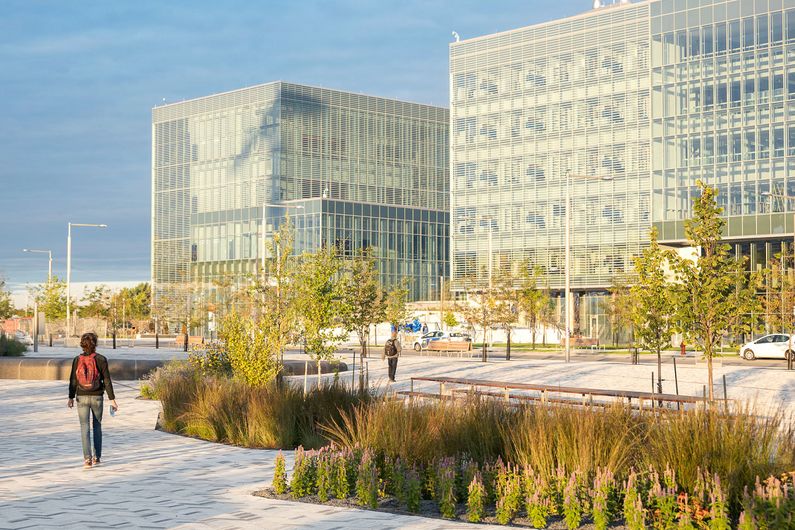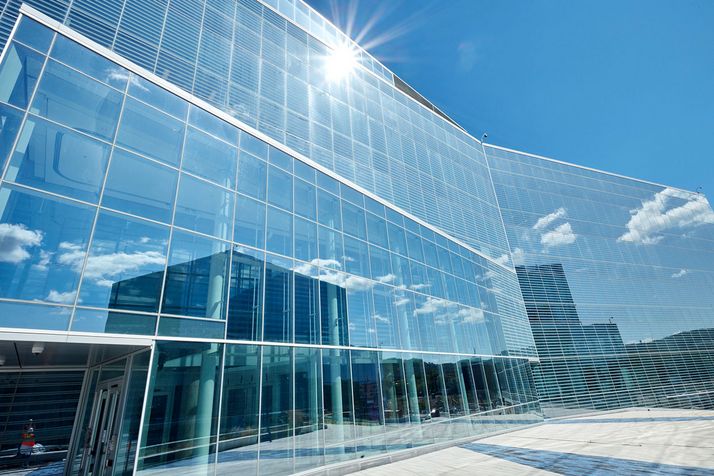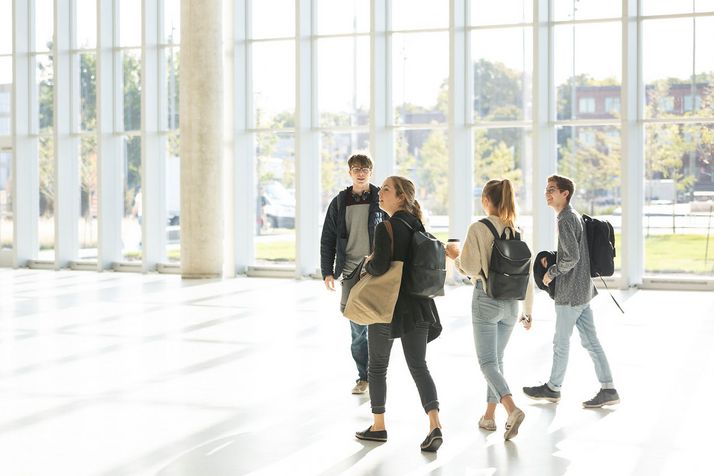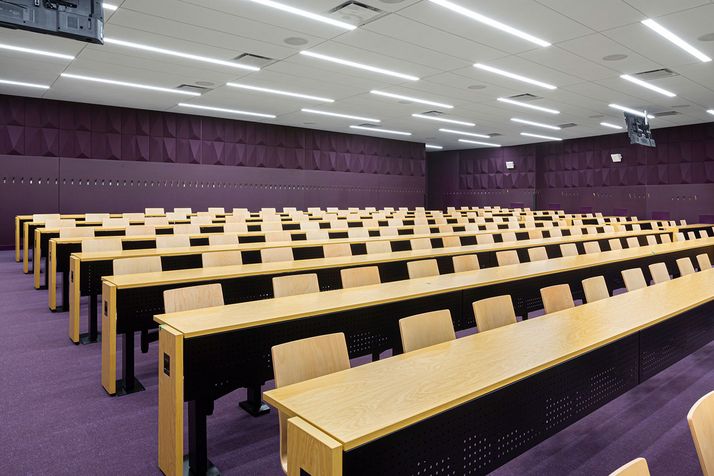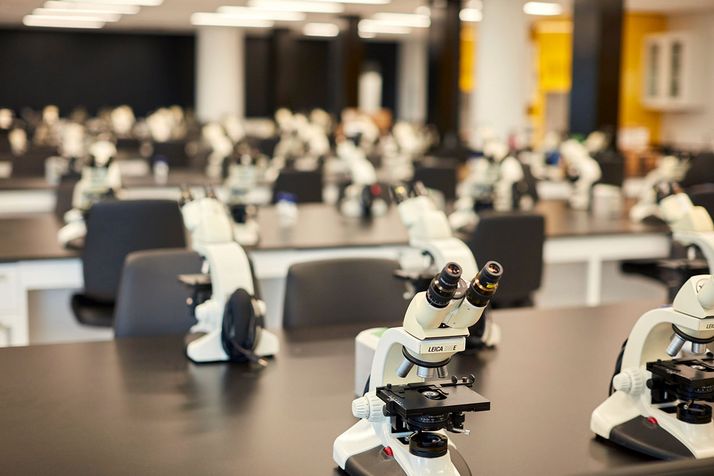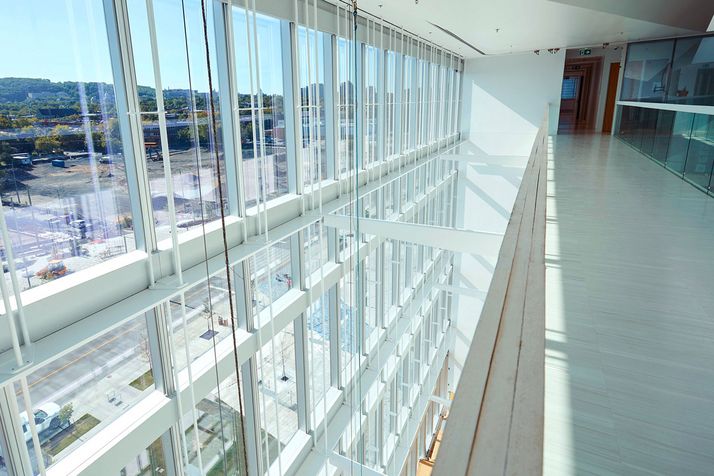Université de Montréal Science Complex holds opening ceremony
- Salle de presse
09/20/2019
- UdeMNouvelles
Three years after the first shovelful of earth was turned, the Science Complex at the MIL Campus welcomes the university community.
The Université de Montréal (UdeM) held the official opening ceremony today for the Science Complex, the cornerstone of its new MIL Campus, with Guy Breton, Rector of the University, François Legault, Premier of Québec, Pierre Fitzgibbon, Minister of Economy and Innovation and Minister Responsible for the Lanaudière Region, Chantal Rouleau, Minister for Transport, Minister Responsible for the Metropolis and the Montréal Region, Valérie Plante, Mayor of Montréal, and hundreds of guests from the academic, scientific, business, cultural and local communities in attendance.
“A ribbon-cutting for a new building at a university isn’t an everyday event; one for a brand-new campus even less so,” said Guy Breton. “In opening this unique facility dedicated to scientific teaching and research, the Université de Montréal is providing the community with a space designed for contemporary science and place where talent can shine. But the impact of the MIL Campus extends beyond our core mission. This project is also the spark for the revitalization of an entire neighbourhood in the Middle of the Island of Montréal, hence the name MIL Campus.”
This first phase of developing the MIL Campus has required investments on the order of $350 million. The Government of Québec contributed $145 million to construction of the Science Complex and the Government of Canada $84 million. The remaining $116 million was provided by the university, including proceeds from its most recent major fundraising campaign, Campus Montréal.
Redevelopment of the former railroad switching yard also required a $174 million investment, including $152.5 million in municipal works. The Government of Québec and the Government of Canada contributed $30 million each. The work included decontamination of the site and construction of water retention basins and urban infrastructure, including streets, parks and a railway bridge.
“I am indeed pleased to observe first-hand the outcome of the work resulting from the Québec government’s financial contribution. Three words come to mind: superb, modern and attractive. This future multidisciplinary integration hub for research and training will foster a wide range of collaboration, independent, interdisciplinary research, training and, I am convinced, significant breakthroughs, creativity and economic spinoff. It marks a striking gain for Montréal and for Québec as a whole. We can be proud of it,” mentioned Premier François Legault.
“The Québec government fully recognizes the importance of developing modern university facilities such as the new MIL Science complex. Projects like this are vital to providing students a stimulating environment geared to learning and to preparing future generations of highly motivated researchers and entrepreneurs. The new MIL Campus will also create greater synergy between research and innovation, while fostering a collaborative atmosphere that enables Université de Montréal to connect with businesses in a wide range of sectors,” noted Pierre Fitzgibbon, Minister of Economy and Innovation.
“Montréal is renewing itself and developing. Promising, innovative projects such as this one also enable Montréal to prosper, set itself apart and broaden its influence. I share the pride of those who have made possible this great achievement. Moreover, I would like to emphasize the commitment of the individuals who are continuing to develop the campus, for students, residents, Montrealers and Quebecers,” added Minister for Transport and Minister Responsible for the Metropolis and the Montréal Region Chantal Rouleau.
“Our party recognized at an early date the vital importance of this project, not only for the Université de Montréal but for all training and research in the pure sciences in Québec,” said Pierre Arcand, MNA for Mont-Royal-Outremont and Leader of the Official Opposition. “These new state-of-the-art buildings will equip us to expand knowledge and will enhance our international drawing power. We have reason to be proud.”
“We seldom have the opportunity to inaugurate a brand-new neighbourhood,” said Montréal Mayor Valérie Plante. “But that is the privilege we have today because of the MIL Campus. Thanks to the partnership between the City of Montréal and the Université de Montréal, we can now celebrate one of the largest transformative projects Montréal has ever seen, and Montréal’s first flagship sustainable urban planning project. The MIL Campus confirms Montréal’s reputation as a city of knowledge and also as a modern city that is responsive to residents’ needs and capable of creating a diverse, sustainable, mixed neighbourhood that is integrated into its surroundings.”
Largest university construction project in Canada
Building the Science Complex took three years and presented a number of technical challenges, notably the need to excavate bedrock lying directly above a subway tunnel, with the many precautions that this entailed. To supply fresh air to all of the building’s 200 laboratories simultaneously, the ventilation system had to be designed to pump 16,000 m3 of air per minute – the equivalent of 6 Olympic swimming pools. With 4,000 workers on site, the Science Complex was the largest university construction project in Canada and the fourth largest construction project in Québec, after the Université de Montréal Hospital Centre (CHUM), the Samuel de Champlain Bridge and the Turcot Interchange.
The MIL Campus also embodies the university’s commitment to continue its development without adding buildings on the flanks of Mount Royal. The spaces that the science departments are vacating at the Mount Royal Campus will be renovated to accommodate offices and departments with fewer technical demands while protecting the campus’s natural and built heritage. The university will also gradually terminate the leases on rented space and enhance its historical campus.
A Science Complex with cutting-edge technology
The Science Complex’s 60,000 m2 of floor space are now home to the students, faculty and staff of the departments of Chemistry, Physics, Geography and Biological Sciences in the Faculty of Arts and Science. The building consists of two wings, connected by a library. In all, about 2,400 people are now using the Complex.
Wing B of the Complex is six storeys high and houses 10 teaching laboratories, nearly 190 research laboratories and state-of-the-art scientific facilities. No fewer than 16 research chairs are based in the Complex. Wing A is five storeys and contains 11 classrooms, including 6 auditoriums.
The library has 330 individual workspaces and 13 group study rooms. Its leading-edge facilities include a visualization laboratory with a wall of 27 high-definition interactive touchscreens, a digital publishing studio, and a map library comprising a collection of geographic maps, aerial photographs and atlases, along with computers configured to make optimal use of geospatial data.
More than a new campus, a new neighbourhood
From the start of the MIL Campus project, UdeM has worked with the City of Montréal to create not just a new university campus but an entirely new neighbourhood: MIL Montréal. As Guy Breton explains, “I am especially proud of how successfully the teams at UdeM and the City of Montréal have worked together to meet the daring challenge that this project represented. In just a few years, we have transformed a railyard into a neighbourhood that is a great place to live, study and work, and even to go for a stroll or to garden.”
For the past five years, community organizations have been using undeveloped spaces on UdeM’s extensive landholdings for urban agriculture, citizen education and cultural development projects. These pop-up projects represent a new approach to making use of lands in transition.
The MIL Montréal neighbourhood includes the MIL Campus and the surrounding area, a total of 118 hectares. The former brownfield has now been completely redeveloped by UdeM and the City of Montréal, and reconnected to surrounding neighbourhoods. Its new east-west artery, Thérèse-Lavoie-Roux Street, currently runs from Durocher Street to McEachran Avenue in Outremont. It will eventually be extended to Avenue du Parc. A north-south footbridge passes over the railroad tracks and connects the Science Complex to the Acadie metro station. It will be called the Passerelle Marcelle-et-Jean-Coutu in recognition of the extremely generous donation received from the Fondation Marcelle et Jean Coutu. The City of Montréal has also built three new parks and a public square, with a total area of 4 hectares, that will be enjoyed by the university community and all Montrealers.
Next steps
The Université de Montréal plans to build two new wings on either side of the Science Complex to house the university’s Department of Mathematics and Statistics and Department of Computer Science and Operations Research. The addition of these two departments will strengthen the MIL Campus as a centre of the sciences. Plans are also being considered to build a digital innovation centre to support entrepreneurship among researchers and students.
Festivities continue
On Saturday, September 21, starting at 2 p.m., the public can visit the new Science Complex and the surrounding MIL Montréal neighbourhood during MIL en fête, a community celebration organized in partnership with the City of Montréal. The day’s festivities will include a corn roast, a treasure hunt, guided tours, information booths and more.
The festivities will continue every evening at 8 p.m. from September 21 to 28, when the MIL Campus and the MIL Montréal neighbourhood will be enlivened by MIL en lumière, a program of outdoor animated video projections on the Science Complex’s big western wall. The show was designed by six students from UdeM’s Faculty of Environmental Design with the support of mentors from Moment Factory, a multimedia company located near the MIL Campus that is committed to community engagement. This presentation was also made possible by support from Solotech.
Media contact
-
Geneviève O'Meara
Université de Montréal
Tel: 514 709-4143


